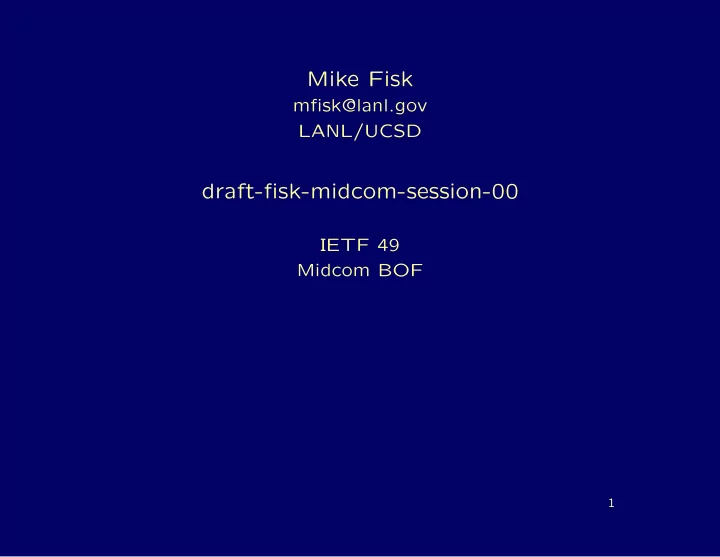

Mike Fisk mfisk@lanl.gov LANL/UCSD draft-fisk-midcom-session-00 IETF 49 Midcom BOF 1
This presentation • Is about: Interactions between middleboxes and untrusted, end-host applications • Is not about: (but is complementary to) Middlebox control by trusted application-layer gateways 2
Man-in-the-street Definitions of a Middlebox “A pragmatic device that transparently fixes packet flows be- tween flawed endpoints.” — Engineer running a network “A flawed device that breaks transparency by impeding the flow of packets between endpoints.” — End-to-end/transparency purist — Frustrated user Examples: Firewall, NAT, TCP PEP, etc... Flawed? A question of agility: Incapable of adequately supporting a necessary protocol or policy. 3
Incapable of adequately supporting a necessary protocol or policy. Adequate = securely, fairly, ... Protocol = IPv6, IPsec, window scaling, global addresses, session bundles, ... Incapable = Not under your administrative domain of control • Site’s networking group can’t manage all of site’s desktops • Desktop users can’t control the network provider’s firewall 4
End-to-end Nirvana • Every end host is well-managed and supports everything nec- essary to work across every kind of network (IPv4, IPv6, Long Fat Networks, wireless, adversarial). • Deployment cost: Deploy each new feature to each host Reality • Update end hosts once every few years • All other changes made with middleboxes 5
Current Trend • Network peers provide services that enable end nodes to work across every kind of network – e.g. SOCKS, RSIP, IPsec tunneling, HTTP Proxies – Clients are aware of middlebox and request functionality • Deployment cost: Deploy each framework protocol to each host and then update/manage small number of servers. – Server deals with changing policies and protocols – Clients are less well managed and trusted – Clients submit themselves to the whims of servers 6
Observations Application only sees end-to-end byte stream or message pay- loads. Expectation is that packets are end-to-end, but frequently not so. Middleboxes perform transport splicing/spoofing. Why not have add a thin abstraction layer between the applica- tion and the transport protocols to provide end-to-end stream of messages over a series of transport connections? 7
Future? A Session Setup Protocol Deploy a single framework protocol to each host and then up- date/manage small number of servers. • Provide end-to-end byte stream or datagram payloads • Relay data across a series of transport layer connections • Middleboxes operate only at transport endpoints; no mucking with something that is supposed to be e2e. • Applications agree (or not) to the requirements (policy) of the middlebox • Is a single, flexible framework protocol feasible? Good question. Let’s try. Encouraging thoughts: – SOCKS is used for many applications. – Who’d have thought that HTTP would be used for every- thing? (RPC, e-mail, etc.) 8
Requirements • Middlebox discovery • Mutual authentication ( n -way) • Encryption (e2e or between hops) • Abstract view of e2e network connection without assuming e2e packets – Build (a series of) transport connections between middle- boxes • Compatibility with current protocols and middleboxes – Some new protocols (telephony, etc.) have more freedom • Dynamic reconfiguration (mobility, topology changes) – New middlebox in path triggers renegotiation – One or more transport hops may change (TCP Connec- tion Migration) • Minimize need for Application Layer Gateways 9
End A Midpoint 1 Midpoint 1 End B Discover Midpoint Ack Discover (Midpoint, Encrypt, Authenticate) Negotiate Encryption Successful GSSAPI Exchange Ack Discover Endpoint 10
Design Decisions How much of the needed functionality is already present in pro- tocols like SOCKS and SIP? New IP option for discovery. Use SOCKS as base for setting-up each transport conn? How much of this is just engineering and how much is still ex- perimental? We have experience with several point-solutions. Now we just need to generalize. Should this protocol be distinct from a protocol that allows ALG control? 11
Questions? Comments? Rants? draft-fisk-midcom-session-00 mfisk@lanl.gov 12
Recommend
More recommend